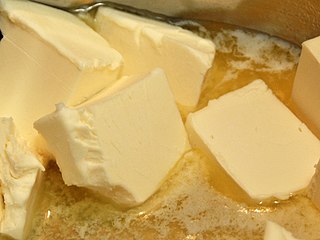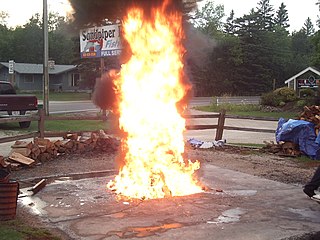Related Research Articles

Pizza cheese encompasses several varieties and types of cheeses and dairy products that are designed and manufactured for use specifically on pizza. These include processed and modified cheese, such as mozzarella-like processed cheeses and mozzarella variants. The term can also refer to any type of cheese suitable for use on pizza. The most popular cheeses used in the preparation of pizza are mozzarella, provolone, cheddar and Parmesan. Emmental, pecorino romano and ricotta are often used as toppings, and processed pizza cheeses manufactured specifically for pizza are mass-produced. Some mass-produced pizza cheeses are frozen after manufacturing and shipped frozen.

Butter is a dairy product made from the fat and protein components of churned cream. It is a semi-solid emulsion at room temperature, consisting of approximately 80% butterfat. It is used at room temperature as a spread, melted as a condiment, and used as a fat in baking, sauce-making, pan frying, and other cooking procedures.

William Dempster Hoard was an American politician, newspaper publisher, and agriculture advocate who served as the 16th governor of Wisconsin from 1889 to 1891. Called the "father of modern dairying", Hoard's advocacy for scientific agriculture and the expansion of dairy farming has been credited with changing Wisconsin's agricultural economy. He promoted the use of silos and alfalfa for cattle feed, testing for bovine tuberculosis, and raising particular breeds of cattle for milk or meat in his magazine Hoard's Dairyman. His work with the Wisconsin Dairymen's Association led to the export of Wisconsin dairy products to the East Coast and they earned national renown.

The Tillamook County Creamery Association (TCCA) is a farmer-owned dairy cooperative headquartered in Tillamook County, Oregon, United States. The association manufactures and sells dairy products under the "Tillamook" brand name. Its main facility is the Tillamook Creamery, located two miles north of the city of Tillamook on U.S. Route 101.

Government cheese is processed cheese provided to welfare beneficiaries, Food Stamp recipients, and the elderly receiving Social Security in the United States, as well as to food banks and churches. This processed cheese was used in military kitchens during World War II and has been used in schools since the 1950s.

A fish boil is a culinary tradition in areas of Wisconsin and along the coastal Upper Great Lakes, with large Scandinavian populations. Fish boils enjoy a particularly strong presence in Door County, Port Wing and Port Washington, Wisconsin. The meal most often consists of Lake Michigan or Lake Superior whitefish, with other ingredients.

Colby-Jack, or Co-jack/Cojack, is an American marble cheese made from Colby and Monterey Jack. It is classified as semi-hard in texture and is mild due to its two-week aging process. It is generally sold in a full-moon or a half-moon shape when it is young. The flavor of Colby-Jack is mild to mellow. Colby-Jack cheese is mainly produced in the states of Wisconsin and California. It is used in various dishes or as a topping to be melted. These dishes include burgers, pasta bakes, macaroni and cheese, casseroles and so on. It is predominantly used in the United States, and is not readily available internationally.

Wisconsin cheese is cheese made in the U.S. state of Wisconsin. Wisconsin has a long tradition and history of cheese production and it is widely associated in popular culture with cheese and the dairy industry.
The 1933 Wisconsin milk strike was a series of strikes conducted by a cooperative group of Wisconsin dairy farmers in an attempt to raise the price of milk paid to producers during the Great Depression. Three main strike periods occurred in 1933, with length of time and level of violence increasing during each one.

The cuisine of Wisconsin is a type of Midwestern cuisine found throughout the state of Wisconsin in the United States of America. Known as "America's Dairyland", Wisconsin is famous for its cheese as well as other dairy products, such as cheese curds and frozen custard. Other notable foods common to the region include bratwursts, beer, brandy Old Fashioned cocktails, butter burgers, fish fries and fish boils, cranberries, and booyah stew.
A hamburger is a specific type of burger. It is a sandwich that consists of a cooked ground beef meat patty, placed between halves of a sliced bun. Hamburgers are often served with various condiments, such as dill relish (condiment), mayonnaise, and other options including lettuce, tomato, onion, pickles, and cheese.

Prairie Farms Dairy is a dairy cooperative founded in Carlinville, Illinois, and now headquartered in Edwardsville, Illinois, a suburb of St. Louis. As a dairy cooperative, Prairie Farms receives milk from producers and converts it into many different products, including cheese, butter, ice cream, sour cream, cottage cheese, various dips, yogurt, and fluid milk. Prairie Farms also produces and sells juices, flavored drinks, and pre-made iced tea.

Lore Alford Rogers was an American bacteriologist and dairy scientist. He is credited with discovering that butter made from pasteurized sweet cream remained fresher than that made from sour ripened cream, while suggesting that surplus milk could still be sold as concentrated sour milk products. He refined the steps for manufacture of high quality Swiss cheese and, new to the United States, production of Roquefort cheese. He was instrumental in finding ways to discourage fungal growth in sweetened condensed milk and preventing losses in evaporated milk from heat coagulation.
Kingaroy Butter Factory is a heritage-listed former butter factory at 67 William Street, Kingaroy, South Burnett Region, Queensland, Australia. It was designed by Waugh and Josephson and built in 1926. It was added to the Queensland Heritage Register on 9 November 2012.

Dairy salt is a culinary salt product used in the preparation of butter and cheese products that serves to add flavor and act as a food preservative. Dairy salt can vary in terms of quality and purity, with purer varieties being the most desirable for use in foods. Dairy salt has been used since at least the 1890s in England and the United States. In butter preparation, it serves to retain moisture, while in cheeses, it tends to reduce water content and slow the ripening process.

The Agen Warehouse, also known as the 1201 Western Building is an historic former warehouse building located at 1201 Western Avenue in Seattle, Washington. Originally constructed in 1910 by John B. Agen (1856–1920), widely considered the father of the dairy industry in the Northwest, for his wholesale dairy commission business, it was designed by the partnership of John Graham, Sr. and David J. Myers with later additions designed by Graham alone. After years of industrial use, the building was fully restored to its present appearance in 1986 for offices and retail with the addition of a penthouse and was added to the National Register of Historic Places on January 23, 1998.

Agriculture is a significant sector in Wisconsin's economy, producing nearly $104 billion in revenue annually. The significance of the state's agricultural production is exemplified by the depiction of a Holstein cow, an ear of corn, and a wheel of cheese on Wisconsin's state quarter design. In 2017 there were 64,800 farms in the state, operating across 14.3 million acres of land.

The Hiram Smith Hall and Annex is part of the University of Wisconsin-Madison College of Agricultural and Life Sciences. The hall was built in 1891 to house the first permanent dairy school in the western hemisphere, which had been established the year before. The annex was added in 1909 as the dairy school grew. In 1985 the pair were listed on the National Register of Historic Places.

Dairy is a major industry in the U.S. state of Wisconsin. Being known for its dairy production, the state is often called "America's Dairyland." The industry is prominent in official state symbols—being displayed on the state's license plates, state's slogan, and on the state quarter.

Commercial cheesemaking in Wisconsin dates back to the nineteenth century. Early cheesemaking operations began on farmsteads in the Michigan and Wisconsin territories, with large-scale production starting in the mid-1800s. Wisconsin became the largest producer of cheese in the United States in the early 1900s, and in 2019 produced 3.36 billion pounds of cheese in more than 600 varieties, accounting for 27% of all cheese made in the country that year.
References
- 1 2 Ivey, Mike (December 28, 1991). "Year in Review: 1991". Madison Capital Times . Archived from the original on November 4, 2023. Retrieved October 17, 2023– via Newspapers.com.
- 1 2 3 4 5 6 7 8 Brueck, Dana (May 3, 2011). "20 Years Ago Today: Central Storage & Warehouse Fire". NBC15. Archived from the original on October 3, 2023. Retrieved October 2, 2023.
- 1 2 Rivedal, Karen (January 4, 2011). "'Huge Grease Fire' Was a Hot Mess". Wisconsin State Journal . Archived from the original on October 10, 2023. Retrieved October 10, 2023.
- ↑ "Central Storage Warehouse Fire Madison, Wisconsin – Fire Engineering: Firefighter Training and Fire Service News, Rescue". FireEngineering.com. December 1, 1991. Archived from the original on December 8, 2021. Retrieved October 3, 2023.
- 1 2 3 4 5 6 7 8 9 10 Oncken, John (May 11, 2022). "The Great Butter and Cheese Fire of 1991". Wisconsin State Farmer . Archived from the original on October 3, 2023. Retrieved October 2, 2023.
- ↑ Flaherty, Mike (April 3, 1990). "The Butter Cup Runneth Over". Wisconsin Daily State Journal . Archived from the original on October 17, 2023. Retrieved October 4, 2023– via NewspaperArchive.com.
- 1 2 3 4 5 6 7 8 Eggleston, Richard (May 4, 1991). "Fire Destroys Millions of Pounds of Meat and Butter". Madison, Wisconsin. Associated Press. Archived from the original on January 11, 2023. Retrieved October 2, 2023.
- ↑ Munson, Ben (April 30, 2021). "Butter Where Butter Shouldn't Be". Tone Madison. Archived from the original on October 3, 2023. Retrieved October 3, 2023.
- ↑ Loroff, Rebecca (January 8, 2023). "Melted Butter Creates Obstacles, Spills into Canal After Wisconsin Dairy Plant Catches Fire". USA Today . Archived from the original on October 3, 2023. Retrieved October 3, 2023.
- ↑ Rivedal, Karen (January 4, 2011). "Central Storage & Warehouse Has Risen from a Fiery Ooze". Wisconsin State Journal . Archived from the original on October 17, 2023. Retrieved October 10, 2023.